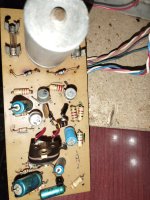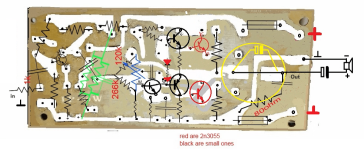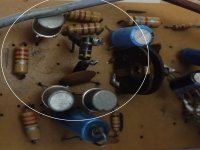I will change small transistors first and i will see what it is doing but i dont know exact part numbers of those small ones otherwise i will order them
This transistor does not need to be removed.
Take photos so that the entire board is included in the frame.
Take photos so that the entire board is included in the frame.
The missing transistor is interesting. It is entirely possible a person removed it, and because the amp still made noise, left it out.
I don't have time to trace it, but a board is seldom designed with a part not needed back then, especially not a transistor. These days, very common, but not back then like that. I can see it connects to an output transistor. Oh well, who knows?
I don't have time to trace it, but a board is seldom designed with a part not needed back then, especially not a transistor. These days, very common, but not back then like that. I can see it connects to an output transistor. Oh well, who knows?
I have seen amplifiers work for years when you would swear they shouldn't work period. One problem is that if something makes noise, people accept it. It could sound god awful, but it makes noise.
I had one stereo come in. Both channels blown. The outputs were four different case styles, I mean completely different! A few transistors you would swear should blow up instantly. Tiny case, lower collector voltage and current ratings than belongs in any output stage. But, it survived for years and I bet the owner thought the guy did a great job.
Just because it made noise for some years does not mean it functioned properly. It stopped when it failed completely, so I do not believe it was ever repaired correctly. The workmanship shows that clearly.
I had one stereo come in. Both channels blown. The outputs were four different case styles, I mean completely different! A few transistors you would swear should blow up instantly. Tiny case, lower collector voltage and current ratings than belongs in any output stage. But, it survived for years and I bet the owner thought the guy did a great job.
Just because it made noise for some years does not mean it functioned properly. It stopped when it failed completely, so I do not believe it was ever repaired correctly. The workmanship shows that clearly.
It make sense, it is really strange how it worked in the past , as i said before if it was board from something made commercially it would be easy i to fix
Well, let's figure out what you have, and what problems there are.
I'm sorry, but I don't have time to do this. Could you place a transistor symbol where the empty pads are in the schematic? Don't worry about PNP or NPN. That will probably show us a great deal.
I'm sorry, but I don't have time to do this. Could you place a transistor symbol where the empty pads are in the schematic? Don't worry about PNP or NPN. That will probably show us a great deal.
I can but i dont know where they should be xdd i can only assume there is spot with 3 holes similar to the arrangement of those small ones but i dont know if it is for that.
Generally if the board has holes in a definite pattern the same as others, it is likely for the same kind of part.
I wish this thing was on my bench. It could get done more quickly. I'm sure some others here are thinking along the same lines. Something in this much of a mess can be a problem for a seasoned tech, for a beginner it is simply unfair! lol!
I wish this thing was on my bench. It could get done more quickly. I'm sure some others here are thinking along the same lines. Something in this much of a mess can be a problem for a seasoned tech, for a beginner it is simply unfair! lol!
i know xdd but it is a mistery and i love to solve misteries xddd its good to use brain sometimes, btw something was done there to keep it running , it was sold do my grandpa like this when it broke grandpa just opened it and he saw that he was not skilled to fix it and that was all for 2 years. so it was done poorly that even i can say xdd restoring board to the original state could be the best option but i dont know what was done to it.
Could you place a transistor symbol where the empty pads are in the schematic? Don't worry about PNP or NPN. That will probably show us a great deal.
Last edited:
should i add it and what it would be ? also will it fix the board ? also do i have to remove small ones ? ones where 2n3055 are ? sry for a lot of questions but i had to ask xdd
Hi Wakh,
Brilliant! That transistor makes perfect sense. It's a buffer for the input stage to drive the output stage. It will enhance the performance without disturbing the DC conditions. Yes, it would work without it.
Many thanks for doing that.
sg97, that transistor should be added once you have it running. It will work better. It doesn't affect what is going on at the moment. It will not change anything elsewhere in the circuit.
A 2N3904 is probably what it would be originally. The resistor on the emitter of Q1 (input transistor) could be increased slightly and this transistor run at a little higher current. Not critical.
Brilliant! That transistor makes perfect sense. It's a buffer for the input stage to drive the output stage. It will enhance the performance without disturbing the DC conditions. Yes, it would work without it.
Many thanks for doing that.
sg97, that transistor should be added once you have it running. It will work better. It doesn't affect what is going on at the moment. It will not change anything elsewhere in the circuit.
A 2N3904 is probably what it would be originally. The resistor on the emitter of Q1 (input transistor) could be increased slightly and this transistor run at a little higher current. Not critical.
wow that is just cool that with that transistor it can work better 😀 btw anatech and you wakh can you tell me what those smal ltransistors are so i can buy new ones ? also i dont know whitch one is npn and pnp. i guess that they my be the problem. music also distorts on playing on them not just 2n3055
Attachments
- Home
- Amplifiers
- Solid State
- transistor amp not working after shorting output


